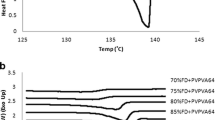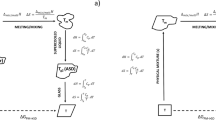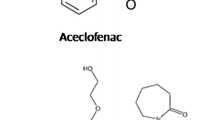Purpose
The objective of the study is to develop a model to estimate the solubility ratio of two polymorphic forms based on the calculation of the free energy difference of two forms at any temperature. This model can be used for compounds with low solubility (a few mole percent) in which infinite dilution can be approximated.
Methods
The model is derived using the melting temperature and heat of fusion for apparent monotropic systems, and the solid–solid transition temperature and heat of transition for apparent enantiotropic systems. A rigorous derivation also requires heat capacity (Cp) measurement of liquid and two solid forms. This model is validated by collecting thermal properties of polymorphs for several drugs using conventional or modulated differential scanning calorimetry. From these properties the solubility ratio of two polymorphs is evaluated using the model and compared with the experimental value at different temperatures.
Results
The predicted values using the full model agree well with the experimental ones. For the purpose of easy measurement, working equations without Cp terms are also applied. Ignoring Cp may result in an error of 10% or less, suggesting that the working equation is applicable in practice. Additional error may be generated for the apparent enantiotropic systems due to the inconsistency between the observed solid–solid transition temperature and the true thermodynamic transition temperature. This inconsistency allows the predicted solubility ratios (low melt/high melt) to be smaller. Therefore, a correction factor of 1.1 is recommended to reduce the error when the working equation is used to estimate the solubility ratio of an enantiotropic system.
Conclusions
The study of the free energy changes of two crystalline forms of a drug allows for the development of a model that successfully predicts the solubility ratio at any temperature from their thermal properties. This model provides a thermodynamic foundation as to how the free energy difference of two polymorphs is reflected by their equilibrium solubilities. It also provides a quick and practical way of evaluating the relative solubility of two polymorphs from single differential scanning calorimetry runs.


Similar content being viewed by others
References
S. R. Byrn R. R. Pfeiffer J. G. Stowell (1999) Solid-State Chemistry of Drugs SSCI Inc. West Lafayette, IN
A. A. Noyes W. R. Whitney (1897) ArticleTitleThe rate of solution of solid substances in their own solutions J. Am. Chem. Soc. 19 930–934
T. T. Higuchi D. J. W. Grant (1990) Solubility Behavior of Organic Compounds John Wiley and Sons New York 22–36
C.-H. Gu D. J. W. Grant (2001) ArticleTitleEstimating the relative stability of polymorphs and hydrates from heats of solution and solubility data J. Pharm. Sci. 90 1277–1287
L. Yu (1995) ArticleTitleInferring thermodynamic stability relationship of polymorphs from melting data J. Pharm. Sci. 84 966–974
S. H. Yalkowsky S. Banerjee (1992) Aqueous Solubility: Methods of Estimation for Organic Compounds Marcel Dekker New York
A. Burger R. Ramberger (1979) ArticleTitleOn the polymorphism of pharmaceuticals and other molecular crystals. I Mikrochim. Acta (Wien) 2 259–271
E. V. Boldyreva V. A. Drebushchak I. E. Paukov Y. K. Kovalevskaya T. N. Drebushchak (2004) ArticleTitleDSC and adiabatic calorimetry study of the polymorphs of paracetamol, an old problem revisited J. Therm. Anal. Calorim. 77 607–623
G. Defossemont S. L. Randzio B. Legendre (2004) ArticleTitleContributions of calorimetry for Cp determination and of scanning transitiometry for the study of polymorphism Cryst. Growth Des. 4 1169–1174
R. J. Behme D. Brooke (1991) ArticleTitleHeat of fusion measurement of a low melting polymorph of carbamazepine that undergoes multiple-phase changes during differential scanning calorimetry analysis J. Pharm. Sci. 80 986–990
M. R. Caira R. Mohamed (1992) ArticleTitlePositive identification of two orthorhombic polymorphs of sulfamerazine (C11H12N4O2S), their thermal analyses and structural comparison Acta Crystallogr. B48 492–498
B. Legendre Y. Feutelais (2004) ArticleTitlePolymorphic and thermodynamic study of indomethacin J. Therm. Anal. Calorim. 76 255–264
B. C. Hancock M. Parks (2000) ArticleTitleWhat is the true solubility advantage for amorphous pharmaceuticals? Pharm. Res. 17 397–404
S. Ghodbane J. A. McCauley (1990) ArticleTitleStudy of the polymorphism of 3-(((3-(2-(7-chloro-2-quinolinyl)-(E)-ethenyl)phenyl) ((3-(dimethylamino-3-oxopropyl) thio) methyl)-thio) propanoic acid (MK571) by DSC, TG, XRPD and solubility measurements Int. J. Pharm. 59 281–286
A. Burger A. Lettenbichler (2000) ArticleTitlePolymorphism and preformulation studies of lifibrol Eur. J. Pharm. Biopharm. 49 65–72
A. Burger R. Ramberger (1980) ArticleTitleThermodynamic relationships between polymorphic modifications—flufenamic acid and mefenamic acid Mikrochim. Acta. 1 17–28
S. Romero B. Escalera P. Bustamante (1999) ArticleTitleSolubility behavior of polymorphs I and II of mefenamic acid in solvent mixtures Int. J. Pharm. 178 193–202
M. Kanke K. Sekiguchi (1973) ArticleTitleDissolution behavior of solid drugs II. Determination of the transition temperature of sulfathiazole polymorphs by measuring the initial rates Chem. Pharm. Bull. 21 878–884
Acknowledgments
The authors would like to thank Dr. Hitoshi Hatakeyama and Dr. Stephan Boerrigter for their valuable discussions. The study is financially supported by The Purdue–Wisconsin–Michigan Program on the Chemical and Physical Stability of Pharmaceutical Solids.
Author information
Authors and Affiliations
Corresponding author
Rights and permissions
About this article
Cite this article
Mao, C., Pinal, R. & Morris, K.R. A Quantitative Model to Evaluate Solubility Relationship of Polymorphs from Their Thermal Properties. Pharm Res 22, 1149–1157 (2005). https://doi.org/10.1007/s11095-005-5363-8
Received:
Accepted:
Published:
Issue Date:
DOI: https://doi.org/10.1007/s11095-005-5363-8




